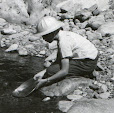Details are current as of December 31, 2025.
If you know of any shows not listed here or spot any errors in the listings, please leave a note in the comments.
February 2026
Dates: 21–22
Location: Maple Ridge, British Columbia
Sponsor: Maple Ridge Lapidary Club
Venue: Albion Community Center, 24165 104 Ave
Hours: Sat. 10–4, Sun. 10–4
Admission: Donation
Features: Displays, vendors, live auction, demonstrations, crack a Geode, spin and win
Information: Contact Walt Pinder; Email: wpinder1@gmail.com; Website: www.mapleridgelapidaryclub.com
Dates: 21–22
Location: Monroe, Washington
Sponsor: Washington Prospectors Mining Association
Venue: Evergreen State Fairgrounds (Bldg 500), 14405 179th Ave SE
Hours: Sat. 9–5, Sun. 9–4
Admission: $5. Children 13 and under free with adult
Features: Over 40 vendors selling gold, silver, gemstones & jewelry, learn how to pan for gold, presentations by industry experts, how to find Ellensburg Blues, learn about metal detectors, buy prospecting gear, buy and sell gold.
Information: https://washingtonprospectors.org/
March 2026
Dates: 7–8
Location: Caldwell, Idaho
Sponsor: Owyhee Gem & Mineral Society;
Venue: O'Connor Field House, 2207 Blaine Street
Hours: Sat. 10–6, Sun. 10–5
Admission: $5 cash, children 11 & under are free with an adult
Features: Dealers, demonstrations, black light display, showcases, wheel of gems, sand dig, grab bags, silent auction, raffles, door prizes every 30 minutes, plus grand prize giveaways
Information: Contact Susan Cassidy, (603) 548-8822; Email: pypnhot@comcast.net; Website: owyheerocks.com
Dates: 13–15
Location: Hillsboro, Oregon
Sponsor: Gem Faire
Venue: Westside Commons, 801 NE 34th Ave
Hours: Fri. 12–6, Sat. 10–6, Sun. 10–5
Admission: General admission $7, free admission for children under 12 years old
Features: Fine jewelry, precious & semi-precious gemstones, millions of beads, crystals, gold & silver, unique gifts from around the world & much more at manufacturer’s prices. Buy directly from the importers & wholesalers. Jewelry repair & cleaning while you shop
Information: Contact Yooy Nelson, (503) 252-8300; Email: info@gemfaire.com; Website: https://gemfaire.com
Dates: 13–15
Location: Central Point, Oregon
Sponsor: Roxy Ann Gem and Mineral Society
Venue: The Expo - Jackson County Fairgrounds, 21 Peninger Road
Hours: Fri. 10–6, Sat. 10–5, Sun. 10–4
Admission: $5, Under 12 are free
Features: There will be vendors with a wide variety of rough to polished specimens, live demos, a raffle, and activities for the kids
Information: Contact Liz Ellingson, Email: gemshow@craterrock.com; Website: www.roxyanngemshow.com
Dates: 14–15
Location: Seattle, Washington
Sponsor: North Seattle Lapidary & Mineral Club
Venue: Crown Hill Center, 9250 14th Ave NE
Hours: Sat. 10–5, Sun. 10–5
Admission: Free
Features: Displays, junior activities, dealers, demonstrations, door prizes
Information: contact Susan Gardner; Email: sgardner3@mindspring.com; Website: www.NorthSeattleRockClub.org
Dates: 20–22
Location: Puyallup, Washington
Sponsor: Gem Faire
Venue: Washington State Fair Event Center, 110 9th Ave. SW
Hours: Fri. 12–6, Sat. 10–6, Sun. 10–5
Admission: General admission $7, Free admission for children under 12 years old
Features: Fine jewelry, precious & semi-precious gemstones, millions of beads, crystals, gold & silver, unique gifts from around the world & much more at manufacturer’s prices. Buy directly from the importers & wholesalers. Jewelry repair & cleaning while you shop. Free parking
Information: contact Yooy Nelson, (503) 252-8300; Email: info@gemfaire.com; Website: https://gemfaire.com
Dates: 27–29
Location: Eugene, Oregon
Sponsor: Gem Faire
Venue: Lane Events Center, 796 W. 13th Ave
Hours: Fri. 12–6, Sat. 10–6, Sun. 10–5
Admission: General admission $7, Free admission for children under 12 years old
Features: Fine jewelry, precious & semi-precious gemstones, millions of beads, crystals, gold & silver, unique gifts from around the world & much more at manufacturer’s prices. Buy directly from the importers & wholesalers. Jewelry repair & cleaning while you shop. Free parking
Information: contact Yooy Nelson, (503) 252-8300; Email: info@gemfaire.com; Website: https://gemfaire.com
April 2026
Dates: 17–19
Location: Rickreall, Oregon
Sponsor: Willamete Agate and Mineral
Venue: Polk County Fairgrounds, 520 S Pacific Hwy W
Hours: Fri. 9–5, Sat. 9–5, Sun. 10–4
Admission: Adults $5, 17 and under free
Features: Free parking, food vendor, demonstrators, silent auction, kids' games, display cases, fluorescent show, and guest speakers
Information: Contact Jessica Suitsev; Email: WAMS.RiverofGems@gmail.com; Website: WAMSI.net
Dates: 24–26
Location: Yakima, Washington
Sponsor: Yakima Rock & Mineral Club
Venue: Central Washington State Fair Grounds - Modern Living Bldg, 1301 South Fair Ave
Hours: Fri. 10–4, Sat. 10–5, Sun. 10–4
Admission: (Not yet available.)
Features: Demonstrations on lapidary equipment, faceting, jewelry making, displays and sales of gemstones, rocks, and minerals from around the world.
Information: http://www.yakimarockclub.com/
Dates: 25–26
Location: Grants Pass, Oregon
Sponsor: Rogue Gem & Geology Club, Inc
Venue: Josephine County Fairgrounds, 1451 Fairgrounds Rd, Pavilion Building
Hours: Sat. 9–5, Sun. 10–4
Admission: Free Admission
Features: Raffle, silent auction, Wheel of Fortune, and a lot of vendors
Information: Contact Michelle Wheeler, (541) 955-0173; Email: 1313althouse@gmail.com; Website: https://www.roguegemandgeology.org/ https://www.facebook.com/GrantsPassRockClub
May 2026
Dates: 2–3
Location: Monroe, Washington
Sponsor: Everett Rock & Gem Club
Venue: Everegreen State Fairgrounds, 14405 179th Ave SE, Weikel Event Center
Hours: Sat. 10–5, Sun. 10–5
Admission: All ages welcome. Free admission
Features: Rocks, gems, jewelry, displays, kids' activities, demonstrations, silent auction, free parking
Information: Contact Candra Burkhardt, (425) 772-3326; Email: Secretary@everettrockclub.com; Website: Everettrockclub.com
Dates: 16–17
Location: Seattle, Washington
Sponsor: Seattle Mineral Market
Venue: Hanger 30 Building @ Magnuson Park, 7400 Sand Point Way NE
Hours: Sat. 10–6, Sun. 11–5
Admission: $7. Free admission for children 14 and under
Features: Over 60 dealers in minerals, fossils, gems, jewelry, mineral art and more, door prizes, free rocks for kids, free parking
Information: https://elementalendeavors.com/seattle-mineral-market
June 2026
Dates: 17–21
Location: Prineville, Oregon
Sponsor: Prineville Rockhound Pow Wow
Venue: Crook County Fairgrounds, 1280 South Main Street
Hours: Wed. 9–5, Thu. 9–5, Fri. 9–5, Sat. 9–5, Sunday, open at 9am, close at 3pm
Admission: Free Admission
Features: Over 40 vendors from across the US, 80th anniversary party with Music and food Events for the public, 4 days of Field Trips
Information: Contact Jim McCoy, (503) 999-8045; Facebook: Prineville Rockhound PowWow; Website: www.prineville.rocks.com

















